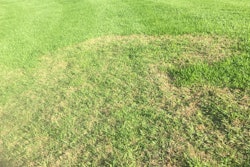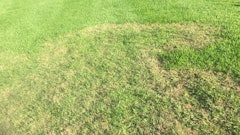
Depending on the region and the type of turf, different times of the year are optimal for overseeding and aerating, says Nick Shomer, director, category management, SiteOne Landscape Supply.
“It also depends if overseeding is being done at the same time (as aeration), which is highly recommended,” Shomer says. “For cool-season grass, fall is a great time because the soil is still warm, and seeds will germinate quickly.”
Shomer and Jamie Ware, product manager at Z Turf Equipment, explain the ins and outs of performing these fall services—so lawn care operators (LCOs) don’t fall behind.
The basics
Before performing aeration services, lawn care operators should be able to educate their customers on what it is and the benefits of it.
Aeration, Ware says, creates holes in the soil to reduce compaction, allowing air, water and other nutrients to reach the roots of the grass.
“Basically, it brings the soil back from compaction caused by people walking on it in high traffic areas or mowers going on it or people driving on it,” Ware says. “Grass that’s missing those nutrients due to compact soil will stress and lose that vibrant green color you see in a good, healthy lawn. In extreme conditions, it can cause the grass to thin out or even die out if it’s too compact.”
The service can also be beneficial for the contractor—especially if they opt to include overseeding. LCOs just need to make sure they have the right equipment in place—particularly a ride-on aerator.
“Ten years ago, when everyone would do aeration, they would have to walk behind the machine and push it,” Ware says. “A lot of times, if you hire someone to aerate with a walk-behind machine, he won’t show up the next day. Ride-on machines are a lot friendlier on the body and a lot more efficient. You can get a lot more done in a day, increasing your profit line.”
Ware adds that some machines even allow operators to overseed while they aerate, aerating in one pass and then driving over it again to cast the seed into the ground.
Shomer and Ware note that doing both in the same service provides benefits when it comes to seed germination.
“You’re already breaking the surface of that soil, so you can put seed down, and it’s a great service to sell on top,” Ware says.
When to book
To ensure contractors have enough time to plan and prepare their machines and labor, Shomer and Ware recommend starting to book these services in late summer.
“LCOs would probably need to start having that conversation about two months to a month-and-a-half prior to that season when the grass is still growing, but it’s not dormant because of heat,” Ware says. “The soil needs to be a little moist.”
What to know
When performing the service, Ware cautions that LCOs should be sure that they’re breaking past the root structure, at least an inch into the soil.
“If you're not getting through the thatch of the grass, then you're not you're not breaking up that compact soul,” Ware says. “I’ve seen a lot of guys go in and basically pull plugs attached—that’s only allowing some moisture get down to the soil, but you're not breaking up the compaction.”
Time constraints also come into play as a challenge with fall services.
“LCOs have a very short window to get this done because you need to make sure the grass is not dormant or stressed from heat, and you want to allow time for those cores sitting on top to break down," Ware says. "If you're overseeding, you want to make sure that the ground's still warm enough for it to germinate."
To help with those time constraints, Ware and Shomer recommend ensuring equipment is properly serviced before the season.
Below are a few questions to ask:
- Is your oil changed?
- Are your chains lubricated and maintained?
- What’s your tire pressure?
- Is your hydrostatic drive ready to go?
- Are the tines actually making contact with the ground. Are they in good condition? Do you have any broken off?
- If you are overseeding, are your rate calibrations correct?
Even when they're in the thick of performing fall lawn care services, LCOs should also ensure that everything is working properly at the beginning and end of each day to reduce the risk of costly downtime.
“Get the machines out early in the summer and get basic scheduled maintenance done early,” Shomer says. “Service labor is just as big of a challenge for contractors as general labor, so schedule maintenance early. Don’t wait until the last minute if you want to save yourself stress.”
In addition to getting the machines ready to tackle the challenges, Shomer suggests also ensuring the labor force is ready.
“Labor can be a challenge in aeration and overseeding—it is difficult work, but having quality equipment is a big help in getting and retaining reliable labor,” Shomer says. “Take the time to train employees well.”



















